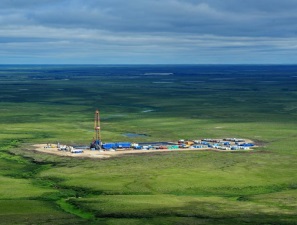The project is part of the joint drilling program implemented by the two companies.
The high-tech well was built in complex geological conditions with the use of innovative technologies and materials. At a length of 2,300 meters, the well has a relatively small vertical depth of only 840 meters and the horizontal section of the shaft of 1,000 meters. The well crosses formations with abnormally high pressure and permafrost. The project envisaged employing a unique drilling technology that prevents rock cuttings from damaging the equipment. To cement the well, the companies used elastic and Arctic cements to boost the quality of work in the conditions of the permafrost layer.
By 2016 when the field is scheduled to become fully operational, the number of wells located at the East-Messoyakha deposit is to reach 63. The intensive drilling program is expected to be implemented using a set of measures aimed at making work more efficient. During the construction, workers use up-to-date plugging materials and short-term cured concrete as well as equipment to collect geophysical data when drilling.
In spring 2015, the East-Messoyakha field saw the completion of a four-year pilot project and the start of production drilling work. The industrial infrastructure for the field, which is due to be commissioned in 4Q16, has been built since 2014. The construction of a pipeline which would connect the field with the Zapolyarye-Purpe pipeline system as well as the building of a gas turbine power plant with the capacity of 84 MW, the CPF and some other facilities is still underway.
The Messoyakhinsky cluster includes the East- and West-Messoyakha fields, which are Russia’s northernmost onshore deposits. Held on par by Gazprom Neft and Rosneft, Messoyakhneftegaz has exploration and development licenses to operate in the area, while Gazprom Neft is the operator of this project.
The fields that were discovered across the Gydan Peninsula, the Tazovsky district of Yamalo-Nenets Autonomous Okrug, 340 km north of the city of Novy Urengoi, are in the Arctic region. The proven С1+С2 reserves within the Messoyakhinsky cluster are close to 480 mln tons of crude and gas condensate, while also being more than 180 BCM of gas. The East-Messoyakha field delivered its first crude in October 2012 during pilot drilling.
14 Декабря 2025 | воскресенье | 04:32


